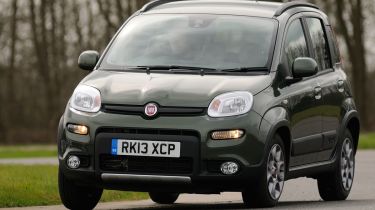Fiat Panda 4x4 TwinAir
The rugged Fiat Panda 4x4 city car mixes tough practicality with funky styling cues
The 4x4 is a worthy flagship for the Panda range. It’s just as capable and fun to drive as the standard car, especially when powered by the TwinAir petrol engine. It’s also more comfortable and manages to add decent off-road ability to its talents. We think it’s the best model in the Panda line-up.
The Fiat Panda really stands out from the crowd. The compact dimensions place it firmly in the city car class, yet the upright bodywork looks like nothing else in that category. And Fiat has done a good job of setting this 4x4 version of the car apart from the standard model.
While it doesn’t have the pure off-roader lines of the Suzuki, there are distinctive 4x4 touches, such as black plastic bumper trims and wheelarch extensions, as well as silver-coloured skid plates at the front and rear. The alloys have been given a dark grey finish, too, while our car’s optional Tuscany Green paint complements the rugged additions nicely.
The cabin has received an appropriately utilitarian makeover. You get unique seat fabric that comes in a variety of two-tone colours, depending what body shade you go for – our car’s sand and olive scheme looked smart. The dashboard gets a special colour finish, too, and the stylish ‘squircle’ designs seen in the standard car have been retained.
Used - available now

2024 BMW
1 Series
24,718 milesAutomaticPetrol2.0L
Cash £24,197
2023 Mercedes
A-Class Saloon
40,015 milesAutomaticPetrol1.3L
Cash £18,697
2023 Audi
A3 Sportback
49,858 milesAutomaticPetrol1.5L
Cash £17,697
2020 Kia
Sportage
18,619 milesManualPetrol1.6L
Cash £16,697It’s easy to get comfortable at the wheel – although a height-adjustable driver’s seat is a £50 option – and there’s plenty of space up front. Unfortunately, while the rear doors open wide, there’s not much legroom in the rear, and it’s virtually non-existent if the front seats are pushed all the way back.
We’ve been critical before about how much kit is left on the Panda’s options list, and even though the 4x4 is at the higher end of the range, it still makes do without some essentials. A 60:40 split folding back seat with three belts costs £50 – not much, but it should be standard.
With that optional seat, the Panda has a clear advantage over the Jimny, which is a strict four-seater, and a cramped one at that. In the back, not only is the Fiat’s boot easier to access thanks to a vertically opening door, it’s bigger, too. Luggage capacity of 225 litres with the seats up and 870 litres with them folded isn’t anything to write home about for a city car, but the figures are well ahead of the Suzuki’s 113 litres and 324 litres.
Fire up the TwinAir two-cylinder petrol turbo, and you’re greeted by a characterful thrum. This encourages you to rev the engine hard, which is necessary to make the most of its modest power output. It’s responsive, too, with a decent spread of mid-range urge. As a result, the Panda easily had the measure of the Suzuki in our acceleration tests, while the addition of a sixth gear meant motorway cruising was far more comfortable.
Another boost for comfort comes from the fact that the 4x4 has softer suspension than the standard Panda. Ride height has been raised by 54mm, too. While that means there’s a touch more body roll, the Fiat remains huge fun to drive, while inspiring lots of confidence in corners. Plus, the four-wheel-drive system doesn’t impair on-road performance, but does provide a lot more grip on slippery surfaces.
Head off the beaten track, and with less ground clearance, plus reactive, not active, four-wheel drive, the Panda can’t quite go everywhere the Jimny can. However, it does have a locking diff and an anti-skid system.
At £13,950, the petrol Panda 4x4 costs £655 more than the Jimny SZ4, but the TwinAir engine is a lot cleaner than the Suzuki’s 1.3-litre petrol, so tax bills are considerably lower and insurance is cheaper, too. Claimed economy is nearly 20mpg better than the Jimny’s, although the margin was closer on test – typical for the TwinAir engine.
Add in a roomier cabin, accomplished road manners plus respectable off-road ability, and the Panda makes a strong case.







